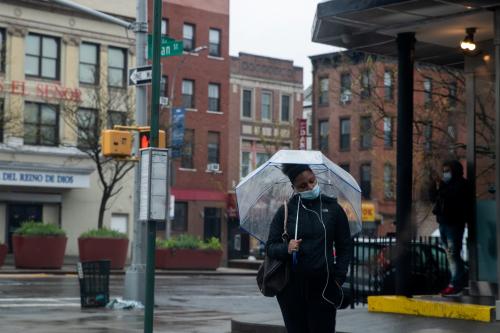When confronting the COVID-19 pandemic’s economic consequences, elected leaders from around the world have quickly created and implemented novel and massive relief programs. Though they vary in detail, the relief strategies can broadly be classified along one key dimension: the extent to which their economic relief is given directly to workers by a government agency or channeled through a pre-existing employment relationship.
Updating earlier work, this analysis examines 20 rich democracies and draws several conclusions that may have relevance for on-going policy discussions about whether the United States and other countries should extend economic relief and how to structure it.
- Among nine rich democracies with comparable government survey data through April, the United States has seen the largest increase in official unemployment measures.
- At least 12 countries—mostly in Europe—have prevented large-scale unemployment by channeling relief through employers to their employees. In some of these countries, a huge share of the workforce has been subsidized, but without severing ties with their employer.
- In total, across these 20 countries representing 660 million workers, 38 million have filed for unemployment insurance during the pandemic, 5.7% of the total. The United States stands out in that 13% of its workers are currently receiving unemployment insurance. Canada, Israel, Ireland, and the United States are the only countries in the group to see double-digit increases in unemployment insurance claims, as a percentage of their workforce.
Even in the countries with low unemployment levels presently, there are no guarantees that employers can avoid layoffs after the wage supports end, but all of these countries have seemingly traversed the worst wave of peak COVID-19 deaths and cases, and they are gradually re-opening. In so far as layoffs increase the risk of permanent separation, which evidence from prior recessions suggests, these patterns suggest that the recovery will likely be more robust and less painful in the countries that avoided layoffs.
At the same time, some economists point to the flexibility of the United States labor market as a strength. During the financial crisis of 2007, unemployment rose more rapidly in the United States than the European Union (from 2007 to 2010) but also declined rapidly from 2010 to 2013, as unemployment in Europe continued to edge up. Yet, this pattern was largely the result of extreme increases in Italy, Portugal, Ireland, Spain, and Greece, whereas other European and developed countries (including the UK, Germany, France, Australia, Canada, Japan, Norway, and Australia) saw a lower initial rise in unemployment and a lower overall rise from 2007 through 2013. Given the unprecedented nature of the current crisis, it remains to be seen how these patterns will play out over the next few months and years.
Measuring economic disruption during the pandemic
This analysis updates and extends research that Hannah Van Drie and I previously published with Brookings in April. That article found that the United States had the largest spike in unemployment out of 20 rich countries, and there was little relationship between business closures and stay-at-home orders and various measures of economic harm related to the pandemic.
As before, the method used here is to calculate changes in the number of workers receiving unemployment benefits or other forms of relief from the time just before the pandemic (usually February) to the most recent government figures (usually early May). That number—the change in the number of workers receiving benefits—is divided by the number of people in the workforce in February to compare across countries.
For a small number of countries with official unemployment data through April, I also show the increase in the number of unemployed during the pandemic as a share of the February workforce. Since statistical offices use similar methods to measure unemployment, these metrics should be regarded as fair comparisons of unemployment, but as I have mentioned previously, the increase in the number of unemployed does not fully capture job loss (nor reductions in hours), because of the complicated ways that workers are classified as unemployed or out of the workforce, depending on how they answer survey questions about whether their layoff is temporary or whether they are actively looking for work.
Off employment and onto government benefits
Countries such as the United States, Israel, and Norway have relied heavily on programs that pay workers through unemployment insurance benefits. In these countries, unemployed workers represent a large share of the workforce.
Norway, for example, has departed from its fellow-Scandinavian countries by deciding neither to create a reduced-time unemployment program nor a program that subsidizes payroll costs. Accordingly, Norway has seen a much larger increase in the share of its workforce claiming unemployment insurance (7 percentage points), compared to other Scandinavian countries (Figure 1). By comparison, Sweden and Denmark have seen only 1 to 2 percentage point increases in the share of their workers claiming unemployment benefits.
Israel’s government has come under pressure for overseeing a massive spike in unemployment claims without offering significant aid to businesses. In the absence of such relief, 25% of Israel’s workers have filed for unemployment benefits since the start of the pandemic.
Hybrid approaches to relief
Several countries created new laws to make unemployment insurance more financially attractive and inclusive to workers than it would normally be, and they also created programs to subsidize employers with the goal of maintaining employment relationships.
The United States is among them. Congress created the Paycheck Protection Program (PPP) and other provisions of the CARES Act to reduce employers’ need for layoffs. Using data from the Small Business Administration (SBA), which oversees the program, I estimate that roughly 10 million U.S. workers have been supported by the program through May 16th. That represents 6% of the U.S. labor force, which makes the program as far-reaching as similar efforts in Denmark and Sweden (Figure 2).
Unlike in those countries, claims for unemployment insurance have spiked in the United States, soaring by 21 million (or 13% of the workforce) since February. Thus, workers are more than twice as likely to have been laid off than to have been supported by PPP. PPP’s problems are well documented, but include the following: a) large businesses (which employ roughly half of American workers) are not eligible; b) it is administered through private banks which were free to reject any qualifying applicant; c) the program is structured, confusingly and oddly, as a loan that can be converted to a grant if many complicated conditions are met; d) the SBA changed the rules to make it less flexible and more risky for many businesses.
At the time, the CARES Act also created the Federal Pandemic Unemployment Compensation, which made unemployment insurance more attractive—by adding $600 in weekly benefits—and relaxed eligibility through Pandemic Unemployment Assistance. Some businesses may have avoided PPP because their employees prefer the larger unemployment insurance benefit, since recent analysis shows that the unemployment insurance benefit often exceeds pre-pandemic earnings.
Like the United States, Canada has taken a hybrid approach between providing benefits through unemployment insurance and through employers but failed to prevent large scale unemployment. 39% of Canadian workers have filed for unemployment insurance through the country’s Emergency Response Benefit, which is similar to U.S. program. Quite likely, many of these workers will be recalled, but for the time being, at least one important tie with their employer has been cut. These unemployment claims come on top of the 7.6% of Canadian workers who have benefitted from the Emergency Wage Subsidy, which generally subsidizes 75% of wages.
The Canadian subsidy program has advantages over PPP in that it is less complicated, administered by the government, and available to companies of all sizes, provided they have lost at least 15% of their revenue. On the other hand, PPP does not require any revenue loss, and my analysis of Gallup survey data suggests that business owners without reported income losses have comprised half of the beneficiaries. Nonetheless, despite the massive jump in Canadian unemployment insurance claims, measured unemployment through government surveys increased by 6.5% of the workforce in Canada and 9.9% in the United States (Figure 3).
Ireland also significantly bolstered unemployment insurance, by creating the Pandemic Unemployment Payment which provides €350 per week and an employer subsidy, called the Temporary COVID-19 Wage Subsidy Scheme, which provides €410 per week for each qualifying employee. As it happens, both programs have been almost equally utilized, with an edge going to the unemployment insurance subsidy. 24% of Irish workers have claimed the unemployment subsidy and 19% have benefitted from the employer program. Yet, official measures of Irish unemployment through April have barely changed—registering only a 0.5% increase—in sharp contrast with Canada and the United States.
Where novel relief programs minimized unemployment claims
Australia, New Zealand, the Netherlands, the United Kingdom, and Denmark are among the countries that created novel relief programs specifically designed to maintain employer-employee relationships. The Netherlands and Australia have released official unemployment data through April and have seen almost no increase. This is consistent with the modest or negligible increases in unemployment insurance claims that these countries have seen.
My previous Brookings article discussed most of these programs, so I will provide only a quick overview here. Australia and New Zealand essentially provide simple flat-rate subsidies to employers to help them maintain their payroll. The subsidy is set such that it replaces income somewhat above the median for each country (roughly 70% of the median for Australia). The Netherlands created NOW, which in Dutch, stands for the Temporary Emergency Bridging Measure for Sustained Employment. It replaces as much as 90% of wages. The Danish program is very similar.
Notably, for each country, the ratio of workers supported through the employer subsidy to workers claiming unemployment benefits is very high. In the Netherlands, there has been almost no change in workers claiming unemployment insurance benefits, but 18% have benefitted from NOW. In the UK, unemployment benefit claims increased such that an additional 2.5% of workers receive them, but 23% of workers are supported by the employer subsidy, which replaces 80% of wages.
Where short-time or reduced-time work program minimized unemployment claims
Germany, France, Switzerland and Sweden have also seen almost no increase in unemployment benefit claims. Yet, each of these countries experienced severe economic disruptions. Instead of laying off workers and having them claim insurance, companies received subsidies to replace a large fraction of the reduced salaries.
Sweden publishes a helpful illustration of how this program works, which is generally applicable. If a company cuts hours by 80%, it can save 72% of its payroll costs, while workers still get paid 88% of their wages, because the national government pays 60% of the salary (which amounts to 75% of the total lost payroll).
It is set up differently than the programs above, and was not designed for a pandemic that completely closes down businesses, but the basic principle is the same as those in the countries listed just above: the public sector makes an agreement with companies not to layoff workers in exchange for covering a large portion of payroll costs.
What works best
Based on this analysis, simple flexible support for employers so they can maintain their staff seems to be the best solution to prevent mass unemployment. Of course, unemployed workers could be rehired after the pandemic ends. BLS data and Gallup survey data suggest that roughly 80% to 85% of layoffs in the United States could be categorized as temporary. Still, better to not have been laid off at all. From May 18 to May 24, Gallup survey data show that 80% of laid off workers report that it is very or somewhat likely that they will return to their job after the pandemic, but thus far only 3% have actually been recalled. This is consistent with evidence from previous recessions that suggests that millions of laid off workers will never return to their employer.
All of the employer subsidy programs discussed above are limited in that they do not explicitly cover non-payroll costs. As I argued back in March, my ideal program would have replaced lost revenue to minimize business bankruptcies, while preserving employer-employee relationships. It is not too late to do this in the United States and other countries struggling with massive unemployment. In any case, existing programs around the world that subsidize the employer-employee relationship seem to be minimizing unemployment.
Hannah Van Drie provided research assistance for this report.






